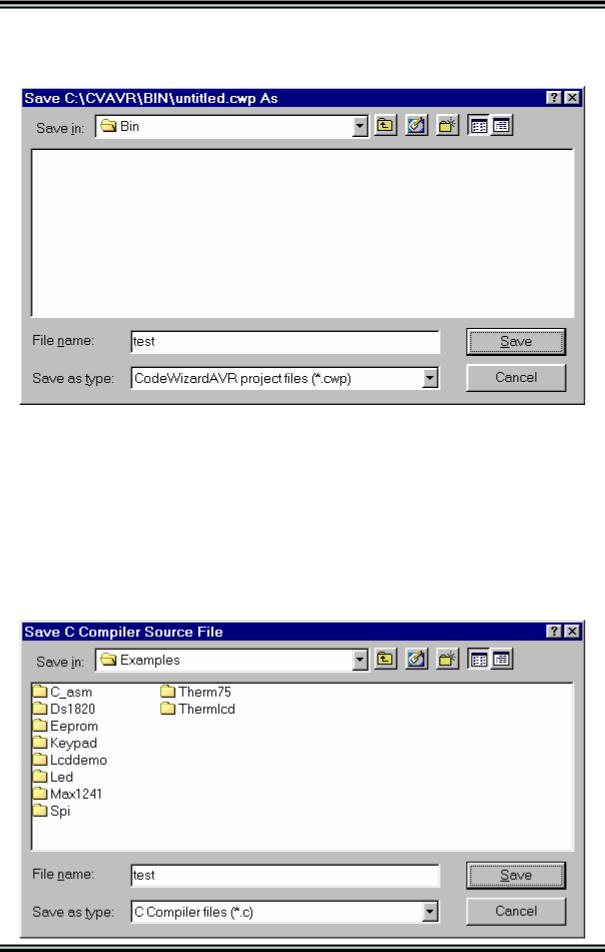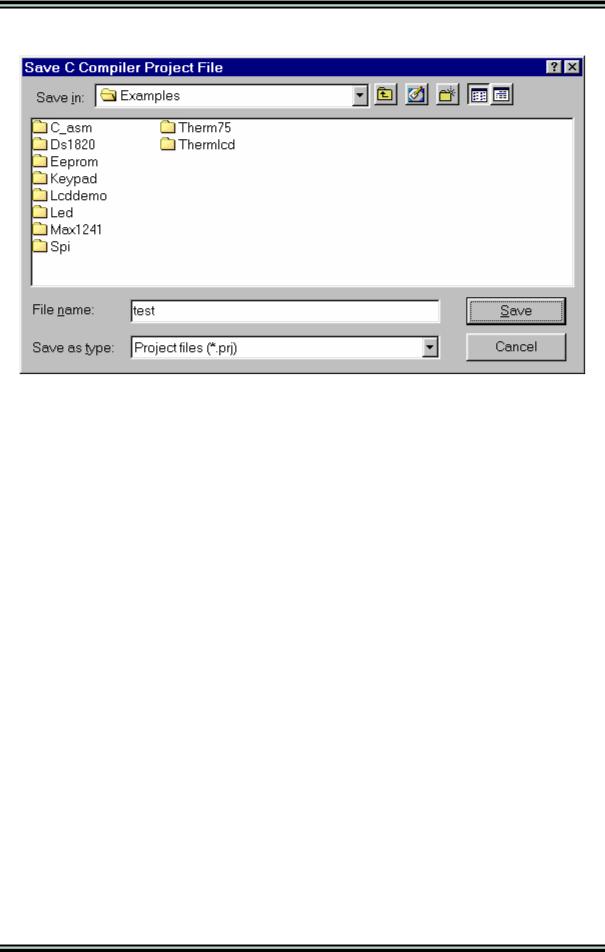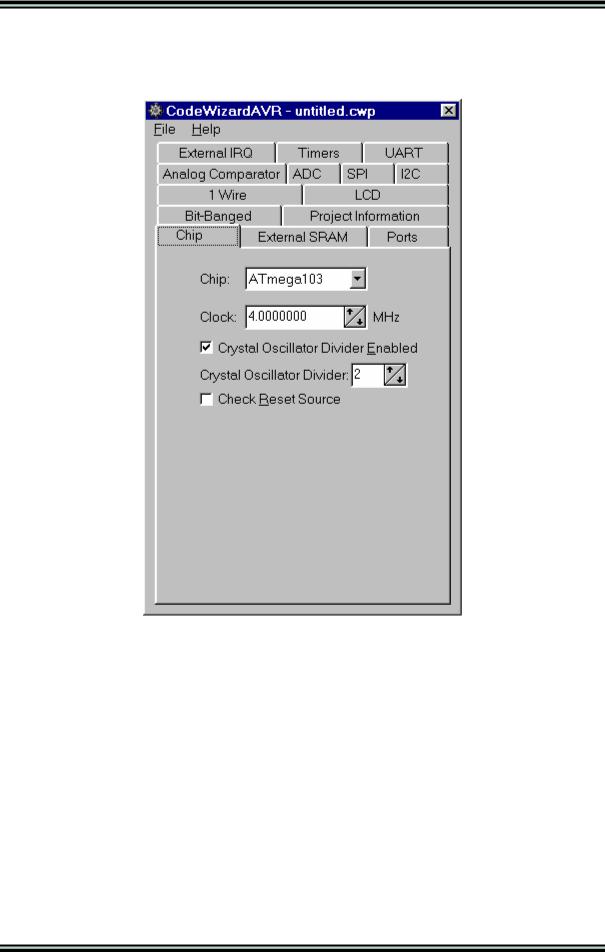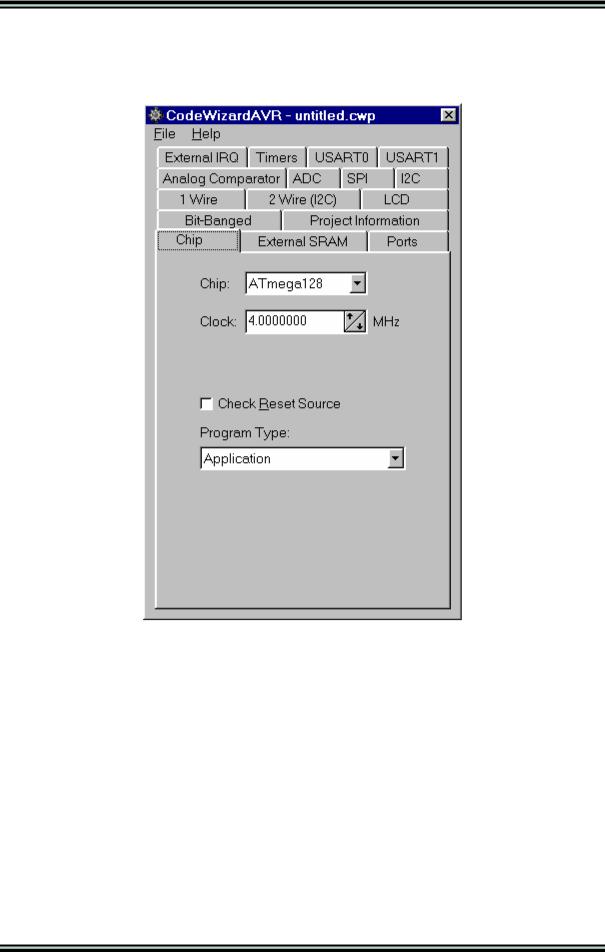
- •Table of Contents
- •1. Introduction
- •2. CodeVisionAVR Integrated Development Environment
- •2.1 Working with Files
- •2.1.1 Creating a New File
- •2.1.2 Opening an Existing File
- •2.1.3 Files History
- •2.1.4 Editing a File
- •2.1.5 Saving a File
- •2.1.6 Renaming a File
- •2.1.7 Printing a File
- •2.1.8 Closing a File
- •2.1.9 Using the Navigator
- •2.1.10 Using Code Templates
- •2.1.11 Using Clipboard History
- •2.2 Working with Projects
- •2.2.1 Creating a New Project
- •2.2.2 Opening an Existing Project
- •2.2.3 Adding Notes or Comments to the Project
- •2.2.4 Configuring the Project
- •2.2.4.1 Adding or removing a File from the Project
- •2.2.4.2 Setting the C Compiler Options
- •2.2.4.3 Executing an User Specified Program before Make
- •2.2.4.4 Transferring the Compiled Program to the AVR Chip after Make
- •2.2.4.5 Executing an User Specified Program after Make
- •2.2.5 Obtaining an Executable Program
- •2.2.5.1 Checking the Project for Syntax Errors
- •2.2.5.2 Compiling the Project
- •2.2.5.3 Making the Project
- •2.2.6 Closing a Project
- •2.3 Tools
- •2.3.1 The AVR Studio Debugger
- •2.3.2 The AVR Chip Programmer
- •2.3.3 The Serial Communication Terminal
- •2.3.4 Executing User Programs
- •2.3.4.1 Configuring the Tools Menu
- •2.4 IDE Settings
- •2.4.1 The View Menu
- •2.4.2 Configuring the Editor
- •2.4.3 Configuring the Assembler
- •2.4.4 Setting the Debugger Path
- •2.4.5 AVR Chip Programmer Setup
- •2.4.6 Serial Communication Terminal Setup
- •2.5 Accessing the Help
- •2.6 Transferring the License to another computer
- •2.7 Connecting to HP InfoTech's Web Site
- •2.8 Contacting HP InfoTech by E-Mail
- •2.9 Quitting the CodeVisionAVR IDE
- •3. CodeVisionAVR C Compiler Reference
- •3.1 The Preprocessor
- •3.2 Comments
- •3.3 Reserved Keywords
- •3.4 Identifiers
- •3.5 Data Types
- •3.6 Constants
- •3.7 Variables
- •3.7.1 Specifying the SRAM Storage Address for Global Variables
- •3.7.2 Bit Variables
- •3.7.3 Allocation of Variables to Registers
- •3.7.4 Structures
- •3.7.5 Unions
- •3.7.6 Enumerations
- •3.7.7 Global Variables Memory Map File
- •3.8 Defining Data Types
- •3.9 Type Conversions
- •3.10 Operators
- •3.11 Functions
- •3.12 Pointers
- •3.13 Accessing the I/O Registers
- •3.13.1 Bit level access to the I/O Registers
- •3.14 Accessing the EEPROM
- •3.15 Using Interrupts
- •3.16 SRAM Memory Organization
- •3.17 Using an External Startup File
- •3.18 Including Assembly Language in Your Program
- •3.18.1 Calling Assembly Functions from C
- •3.19 Creating Libraries
- •3.20 Using the AVR Studio Debugger
- •3.20.1 Using the AVR Studio Debugger version 3
- •3.20.2 Using the AVR Studio Debugger version 4.06 or later
- •3.21 Hints
- •3.22 Limitations
- •4. Library Functions Reference
- •4.1 Character Type Functions
- •4.2 Standard C Input/Output Functions
- •4.3 Standard Library Functions
- •4.4 Mathematical Functions
- •4.5 String Functions
- •4.6 Variable Length Argument Lists Macros
- •4.7 Non-local Jump Functions
- •4.8 BCD Conversion Functions
- •4.9 Gray Code Conversion Functions
- •4.10 Memory Access Functions
- •4.11 LCD Functions
- •4.11.1 LCD Functions for displays with up to 2x40 characters
- •4.11.2 LCD Functions for displays with 4x40 characters
- •4.11.3 LCD Functions for displays connected in 8 bit memory mapped mode
- •4.12 I2C Bus Functions
- •4.12.3 Philips PCF8563 Real Time Clock Functions
- •4.12.4 Philips PCF8583 Real Time Clock Functions
- •4.14 1 Wire Protocol Functions
- •4.14.3 Maxim/Dallas Semiconductor DS2430 EEPROM Functions
- •4.14.4 Maxim/Dallas Semiconductor DS2433 EEPROM Functions
- •4.15 SPI Functions
- •4.16 Power Management Functions
- •4.17 Delay Functions
- •5. CodeWizardAVR Automatic Program Generator
- •5.1 Setting the AVR Chip Options
- •5.2 Setting the External SRAM
- •5.3 Setting the Input/Output Ports
- •5.4 Setting the External Interrupts
- •5.5 Setting the Timers/Counters
- •5.6 Setting the UART or USART
- •5.7 Setting the Analog Comparator
- •5.8 Setting the Analog-Digital Converter
- •5.9 Setting the ATmega406 Voltage Reference
- •5.10 Setting the ATmega406 Coulomb Counter
- •5.11 Setting the SPI Interface
- •5.12 Setting the Universal Serial Interface - USI
- •5.13 Setting the I2C Bus
- •5.13.1 Setting the LM75 devices
- •5.13.2 Setting the DS1621 devices
- •5.13.3 Setting the PCF8563 devices
- •5.13.4 Setting the PCF8583 devices
- •5.13.5 Setting the DS1307 devices
- •5.14 Setting the 1 Wire Bus
- •5.15 Setting the 2 Wire Bus
- •5.16 Setting the CAN Controller
- •5.17 Setting the ATmega169/329/3290/649/6490 LCD Controller
- •5.18 Setting the LCD
- •5.19 Setting the USB Controller
- •5.20 Setting Bit-Banged Peripherals
- •5.21 Specifying the Project Information
- •6. License Agreement
- •6.1 Software License
- •6.2 Liability Disclaimer
- •6.3 Restrictions
- •6.4 Operating License
- •6.5 Back-up and Transfer
- •6.6 Terms
- •6.7 Other Rights and Restrictions
- •7. Technical Support
- •8. Contact Information

CodeVisionAVR
5. CodeWizardAVR Automatic Program Generator
The CodeWizardAVR Automatic Program Generator allows you to easily write all the code needed for implementing the following functions:
•External memory access setup
•Chip reset source identification
•Input/Output Port initialization
•External Interrupts initialization
•Timers/Counters initialization
•Watchdog Timer initialization
•UART initialization and interrupt driven buffered serial communication
•Analog Comparator initialization
•ADC initialization
•SPI Interface initialization
•I2C Bus, LM75 Temperature Sensor, DS1621 Thermometer/Thermostat, PCF8563, PCF8583, DS1302 and DS1307 Real Time Clocks initialization
•1 Wire Bus and DS1820/DS18S20 Temperature Sensors initialization
•LCD module initialization.
The Automatic Program Generator is invoked using the Tools|CodeWizardAVR menu command or by pressing the CodeWizardAVR command bar button.
The File|New menu command allows creating a new CodeWizardAVR project. This project will be named by default untitled.cwp .
The File|Open menu command allows loading an existing CodeWizardAVR project:
© 1998-2007 HP InfoTech S.R.L. |
Page 177 |

CodeVisionAVR
The File|Save menu command allows saving the currently opened CodeWizardAVR project.
The File|Save As menu command allows saving the currently opened CodeWizardAVR project under a new name:
By selecting the File|Program Preview menu option, the code generated by CodeWizardAVR can be viewed in an editor window. This may be useful when applying changes to an existing project, as portions of code generated by the CodeWizardAVR can be copied to the clipboard and then pasted in the project's source files.
If the File|Generate, Save and Exit menu option is selected, CodeWizardAVR will generate the main
.C source and project .PRJ files, save the CodeWizardAVR project .CWP file and return to the CodeVisionAVR IDE.
Eventual pin function conflicts will be prompted to the user, allowing him to correct the errors.
In the course of program generation the user will be prompted for the name of the main C file:
© 1998-2007 HP InfoTech S.R.L. |
Page 178 |

CodeVisionAVR
and for the name of the project file:
Selecting the File|Exit menu option allows you to exit the CodeWizardAVR without generating any program files.
By selecting the Help menu option you can see the help topic that corresponds to the current CodeWizardAVR configuration menu.
© 1998-2007 HP InfoTech S.R.L. |
Page 179 |

CodeVisionAVR
5.1 Setting the AVR Chip Options
By selecting the Chip tab of the CodeWizardAVR, you can set the AVR chip options.
The chip type can be specified using the Chip list box.
The chip clock frequency in MHz can be specified using the Clock spinedit box.
For the AVR chips that contain a crystal oscillator divider, a supplementary Crystal Oscillator Divider Enabled check box is visible.
This check box allows you to enable or disable the crystal oscillator divider.
If the crystal oscillator is enabled, you can specify the division ratio using the Crystal Oscillator Divider spinedit box.
For the AVR chips that allow the identification of the reset source, a supplementary Check Reset Source check box is visible. If it's checked then the CodeWizardAVR will generate code that allows identification of the conditions that caused the chip reset.
© 1998-2007 HP InfoTech S.R.L. |
Page 180 |

CodeVisionAVR
For the AVR chips that allow self-programming, a supplementary Program Type list box is visible. It allows to select the type of the generated code:
•Application
•Boot Loader
© 1998-2007 HP InfoTech S.R.L. |
Page 181 |
